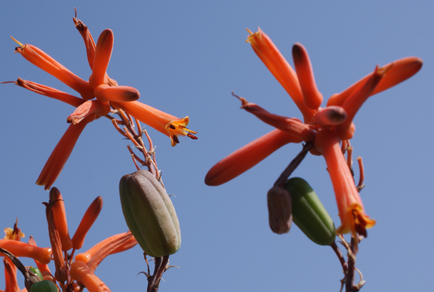Abstract
Aloe burgersfortensis (Asphodelaceae subfam. Alooideae), which generally has been included in the synonymy of A. parvibracteata since 2000, is formally reinstated as an accepted species that is endemic to the southeastern Limpopo and northwestern Mpumalanga provinces of South Africa. Aloe burgersfortensis differs from A. parvibracteata in several vegetative and reproductive morphological characters so warranting its recognition at the rank of species; the differences are quantified and discussed. The typification of the name A. burgersfortensis is reinterpreted and corrected. Both A. burgersfortensis and A. parvibracteata are illustrated and an amplified description is provided for A. burgersfortensis.
References
- Bornman, H. & Hardy, D.[S.] (1971) Aloes of the South African veld. Voortrekkerpers, Johannesburg, 299 pp.
- Carter, S., Lavranos, J.J., Newton, L.E. & Walker, C.C. (2011) Aloes. The definitive guide. Kew Publishing, Royal Botanic Gardens, Kew, Richmond, Surrey, in association with the British Cactus & Succulent Society, London, 719 pp.
- Glen, H.F. & Hardy, D.S. (1987) Nomenclatural notes on three southern African representatives of the genus Aloe. South African Journal of Botany 53 (6): 489–492. https://doi.org/10.1016/S0254-6299(16)31383-7
- Glen, H.F. & Hardy, D.S. (2000) Aloaceae (First part): Aloe. In: Germishuizen, G. (Ed.) Flora of southern Africa Vol. 5, Part 1, Fasc. 1. National Botanical Institute, Pretoria, pp. 1–167.
- Grace, O.M. (2009) Contributions to the systematics and biocultural value of Aloe L. (Asphodelaceae). Ph.D. thesis, University of Pretoria, Pretoria, 158 pp. http://hdl.handle.net/2263/26261
- Grace, O.M., Klopper, R.R., Figueiredo, E. & Smith, G.F. (2011) The aloe names book. Strelitzia 29. South African National Biodiversity Institute, Pretoria, and Royal Botanic Gardens, Kew, 232 pp. http://hdl.handle.net/20.500.12143/270
- Groenewald, B.H. (1941) Die aalwyne van Suid-Afrika, Suidwes-Afrika, Portugees Oos-Afrika, Swaziland, Basoetoeland, en ’n spesiale ondersoek van die klassifikasie, chromosome en areale van die Aloe Maculatae. Die Nasionale Pers Beperk, Bloemfontein, 172 pp.
- IPNI (2023+) The International Plant Names Index. Available from: https://www.ipni.org/ (continuously updated; accessed 31 December 2023)
- Jacobsen, H. (1977) Lexicon of succulent plants. Short descriptions, habitats and synonymy of succulent plants other than Cactaceae. Blandford Press Ltd, Poole, Dorset, 682 pp.
- Jacobsen, H. (1986) A handbook of succulent plants. Descriptions, synonyms and cultural details for succulents other than Cactaceae. Vol. 1. [Fourth, 1986 reprint of the 1960 English edition.] Abromeitiella to Euphorbia. Blandford Press Ltd, Poole, Dorset, 464 pp.
- Jeppe, B. (1969) South African aloes. Purnell & Sons S.A. (Pty) Ltd, Cape Town, Johannesburg, London, 144 pp.
- Judd, E. (1967) What aloe is that? A Purnell Pocketbook. Southern African Series. Purnell, Cape Town & Johannesburg, 76 pp.
- Klopper, R.R. (2015) Contributions to the systematics of the genus Aloe L. (Asphodelaceae: Alooideae) in southern Africa. Ph.D. thesis. University of Pretoria, Pretoria, 712 pp.
- Klopper, R.R., Crouch, N.R. & Smith, G.F. (2013) The 1930s—heyday of aloe discovery and description in southern Africa. Aloe 50: 7–13.
- Kuntze, O. (1898) Revisio generum plantarum: vascularium omnium atque cellularium multarum secundum leges nomeclaturae internationales cum enumeratione plantarum exoticarum in itinere mundi collectarum [...]. Vol. 3. Pars 3. Arthur Felix, Leipzig, [et al.], 576 pp. [https://www.biodiversitylibrary.org/page/3532]
- Newton, L.E. (2020) Aloe. In: Eggli, U. & Nyffeler, R. (Eds.) Illustrated handbook of succulent plants: Monocotyledons, Vol. 1. 2nd edition. Springer-Verlag, Berlin, pp. 485–696.
- Pillans, N.S. (1933) Plants—new and noteworthy [Aloe forsteri]. South African Gardening and Country Life [Cape Town] 23: 140.
- Reynolds, G.W. (1936) Notes on some new aloes from the Transvaal, with descriptions of three new species, and one new variety. The Journal of South African Botany 2: 25–34, + Plates I–III, including seven Figures. [https://archive.org/details/journalofsouthaf02unse/page/24/mode/2up?view=theater]
- Reynolds, G.W. (1950) The aloes of South Africa. The Trustees, The Aloes of South Africa Book Fund, Johannesburg, 520 pp.
- Riley, H.P. & Majumdar, S.K. (1979) The Aloineae. A biosystematics survey. The University of Kentucky Press, place of publication not stated, likely Lexington, Kentucky, 177 pp.; some Index pages not numbered. [https://www.jstor.org/stable/j.ctt130jhd1]
- Salm-Reifferscheidt-Dyck, J.F.M.A.H.I. (1837) Monographia generum aloes et mesembryanthemi, Fascicle 1. Maximillian Cohen, Bonn, 60 plates, 72 pp. https://doi.org/10.5962/bhl.title.153143
- Schönland, S. (1907) On some new and some little known species of South African plants belonging to the genera Aloe, Gasteria, Crassula, Cotyledon and Kalanchoe. Records of the Albany Museum 2: 137–155.
- Smith, G.F. (2003) First field guide to aloes of southern Africa. Struik Nature, Cape Town, 57 pp.
- Smith, G.F. & Van Wyk, B. (2008) Aloes in southern Africa. Struik Nature, an imprint of Penguin Random House SA (Pty) Ltd, Century City, Cape Town, 136 pp.
- Thiers, B. (2023 [continuously updated]) Index herbariorum: a global directory of public herbaria and associated staff. New York Botanical Garden’s Virtual Herbarium. Available from: http://sweetgum.nybg.org/ih/ (accessed 31 December 2023)
- Turland, N.J., Wiersema, J.H., Barrie, F.R., Greuter, W., Hawksworth, D.L., Herendeen, P.S., Knapp, S., Kusber, W.-H., Li, D.-Z., Marhold, K., May, T.W., McNeill, J., Monro, A.M., Prado, J., Price, M.J. & Smith, G.F. (2018) International Code of Nomenclature for algae, fungi, and plants (Shenzhen Code) adopted by the Nineteenth International Botanical Congress Shenzhen, China, July 2017. [Regnum Vegetabile 159]. Koeltz Botanical Books, Glashütten, 254 pp. https://doi.org/10.12705/Code.2018
- Van Wyk, B.-E. & Smith, G.F. (1996) Guide to the aloes of South Africa. 1st edition. Briza Publications, Pretoria, 302 pp.
- Van Wyk, B.-E. & Smith, G.F. (2003) Guide to the aloes of South Africa. 2nd edition. Briza Publications, Pretoria, 304 pp.
- Van Wyk, B.-E. & Smith, G.F. (2014) Guide to the aloes of South Africa. 3rd edition. Briza Publications, Pretoria, 376 pp.
- Walker, C.C. (2010) Gilbert Westacott Reynolds: his studies of Aloe and a bibliography of his work. Bradleya 28: 111–124. https://doi.org/10.25223/brad.n28.2010.a13


